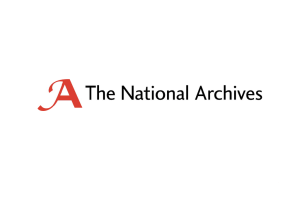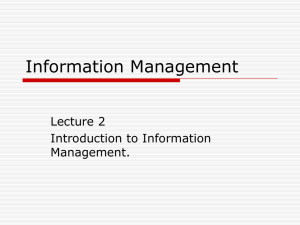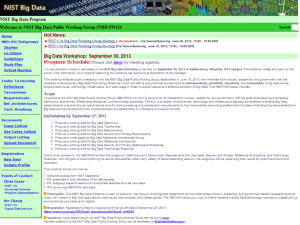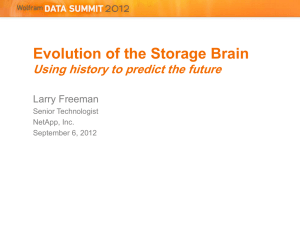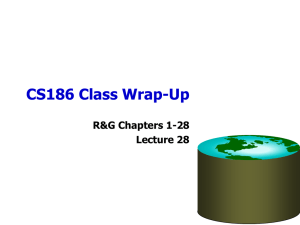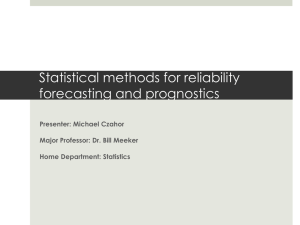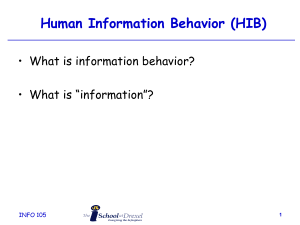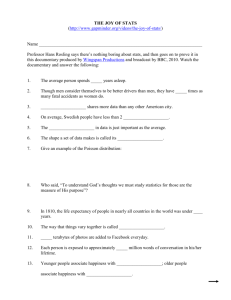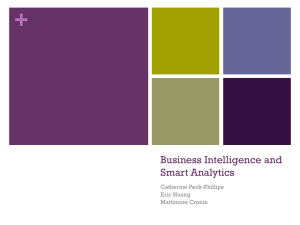Information Seeking Behavior
advertisement
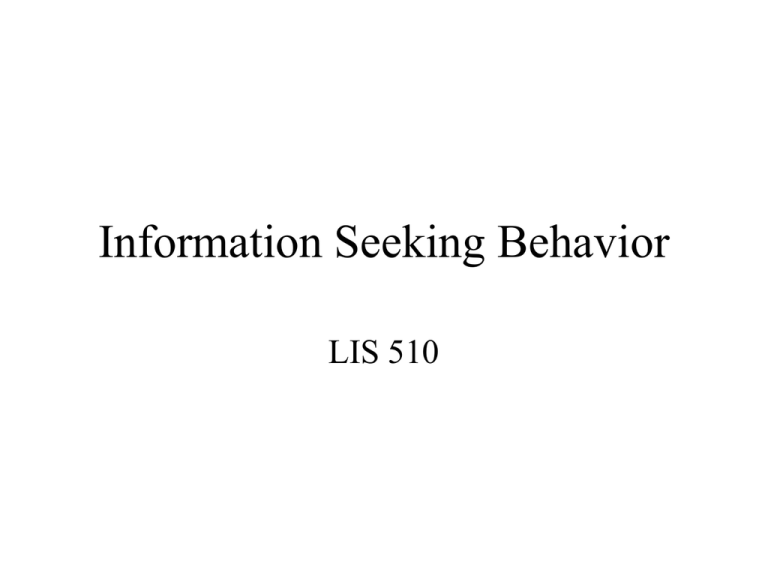
Information Seeking Behavior LIS 510 Introduction • Every day we are deluged by data – It is received through our five senses, which are continuously at work • Wide variety of input sources – – – – Written material (hard copy and electronic) Auditory (speech, radio, CDs, etc.) Imagery (photographs, graphs, etc.) Video (TV, movies, etc.) Information Overload • “The greatest problem of today is how to teach people to ignore the irrelevant, how to refuse to know things, before they are suffocated. For too many facts are as bad as none at all.” (W.H. Auden) Information Theory • Claude Shannon, 1940’s, studying communication • Ways to measure information – Communication: producing the same message at its destination as that seen at its source – Problem: a “noisy channel” can distort the message • Between transmitter and receiver, the message must be encoded • Semantic aspects are irrelevant Noise Message source Transmitter Receiver Channel Destination Information Theory • Better called “Communication Theory” • Communication may be over time and space Message Source Message Encoding Decoding Destination Channel Message Source Message Encoding (writing/indexing) Storage Decoding (Retrieval/Reading) Destination What kinds of information are there? • Text – books, periodicals, WWW, memos, ads – published/refeered • • • • • Film Photos, other Images Broadcast TV, Radio Telephone Conversations Databases How much information is there? Gigabyte 10^9 bytes 1000 megabytes Terabyte 10^12 bytes 1000 gigabytes Petabyte 10^15 bytes 1000 terabytes Exabyte 10^18 bytes 1000 petabytes How Much Information? • Stored Information – – – – Print Film Optical Magnetic • Communicated – – – – Internet Broadcast Phone Mail Print • Annual Production – Books 968,735 = 8 Terabytes (compressed image) – – – – Newspapers 22643 = 25 Terabytes Journals 40000 = 2 Terabytes Magazines 80000 = 10 Terabytes Office Documents 12x10^9 pages = 312 Terabytes – TOTAL 357 Terabytes (1824 scanned, 35 text) Print • Library of Congress Printed book collection – About 18 Million books – About 130 Terabytes (compressed image) – For all of LC we should also assume • • • • • 13M photographs, 5MB each = 65 TB 4M maps, say 200 TB 500K files, 1GB each = 500 TB 3.5M sound recordings, ~2000 TB Grand total: 3 petabytes (~3000 terabytes) • Books in Print – 3.2 Million titles – About 26 Terabytes Film and Image • Film – Photographs = 410 Petabytes per year – Movies = 16 Terabytes (Commercial Production of about 4000 films) – X-Rays = 12 Petabytes Optical Media • • • • CD-Music 90,000 items = 58 TB CD-ROM 3,000 items = 3 TB DVD-Video 5,000 items = 22 TB Total 83 TB Magnetic Media • • • • • Audio Tape 184,200,000 = 184.2 Petabytes Video Tape 355,000,000 = 1420 Floppy disks = 0.07 Removable disks = 1.69 Hard Disks = 500 Medium Type of content Terabytes/Year Terabytes/Year Upper Bound Lower Bound Paper Books 8 7 Newspapers 25 20 Periodicals 12 12 Office documents 312 312 SUBTOTAL 357 351 Film Photographs 410,000 100,000 Cinema 16 16 X-Rays 12,000 12,000 SUBTOTAL 422,000 112,016 Optical Music CDs 58 40 Data CDs 3 3 DVDs 22 22 SUBTOTAL 83 65 Magnetic Camcorder 300,000 300,000 Disk drives 2,555,000 1,000,20 SUBTOTAL 2,855,000 1,300,200 TOTAL 3,277,440 1,412,632 Current Size of Web • There are an estimated 2.1 Billion pages on the Web – About 21 Terabytes – About 7500 further Terabytes in web-accessed DBs. • 610 Billion email messages per year = 11285 TB • Internet Traffic is doubling every 100 days - An estimated 62 Million Americans now use the internet Radio took 38 years to get 50 M listeners, TV took 13 years, the Net took 4 years... Internet Hosts: 1989-2005 1000000 900000 800000 700000 600000 500000 400000 300000 200000 hosts 100000 0 2005 2003 2001 1999 1997 1995 1993 1991 1989 Projected Voice and Data Traffic 30000 25000 20000 Voice Data 15000 10000 5000 0 1996 1997 1998 1999 2000 2001 2002 Language Distribution of Web Content English German Chinese Italian Malay Portuguese Danish Finnish Polish Norwegian Greek Croatian Thai Arabic Others & Unknown Japanese French Spanish Swedish Korean Dutch Czech Russian Hungarian Estonian Bulgarian Basque Turkish Albanian Language Distribution on a 634 Million Web Pages Corpus Language English Japanese German French Chinese Spanish Italian Swedish Malay Korean Portuguese Dutch Danish Czech Finnish Russian Polish Hungarian Norwegian Estonian Greek Bulgarian Croatian Basque Thai Turkish Arabic Albanian Others & Unknown Tota l Number of Docs 453,685,690 43,271,080 32,253,563 11,107,994 9,642,450 6,965,560 5,638,827 4,392,709 3,619,227 3,200,762 3,014,294 2,745,610 1,911,677 1,428,385 1,312,932 1,150,127 952,716 760,162 607,211 456,613 393,360 392,777 310,237 258,074 99,691 81,218 38,167 17,779 44,561,062 634,269,953 Percentage 71.5288% 6.8222% 5.0851% 1.7513% 1.5202% 1.0982% 0.8890% 0.6926% 0.5706% 0.5046% 0.4752% 0.4329% 0.3014% 0.2252% 0.2070% 0.1813% 0.1502% 0.1198% 0.0957% 0.0720% 0.0620% 0.0619% 0.0489% 0.0407% 0.0157% 0.0128% 0.0060% 0.0028% 7.0256% 100% Human Memory – Landauer 86: Human brain holds 200MB • looked at rate of information intake and rate of forgetting, and amount of information adults need for normal tasks – 6B people on earth implies total memory of all people alive about 1,200 petabytes – Another way: • estimate that people take in a byte/sec • lifetime 250,000 days or 2B sec • result is 2 GB (doesn’t count synthesizing new info) Data and Information • These two terms are quite often used interchangeably – used without any definitions or explanation • There are no standard definitions for these two terms • Two possible definitions: Data and Information (cont.) • Data – items such as text, facts, numbers, images or sounds that may or may not be useful for a particular purpose • Information – data which has been processed so that its form and content are appropriate for a particular purpose Intuitive Notion • Information must – Be something, although the exact nature (substance, energy, or abstract concept) is not clear; – Be “new”: repetition of previously received messages is not informative – Be “true”: false or counterfactual information is “misinformation” – Be “about” something • This human-centered approach emphasizes meaning and use of message Knowledge • Quite often the terms information and knowledge are used interchangeably • One possible definition of knowledge – a combination of information, instincts, rules, ideas, procedures and experience that guide actions and decisions Knowledge (cont.) • Two types of knowledge – Tacit • also called implicit, private or personal knowledge • knowledge held by an individual; may not have been articulated or may not be articulatable – For example, how does Michael Jordan accomplish his “slam dunks” Knowledge (cont.) – Explicit • also called public or social knowledge • expressed in a form that makes it available to others – usually in a written form, but may be in other forms such as verbal Continuum • Quite often data, information and knowledge are expressed as a continuum: • Data => Information => Knowledge Pyramid • Data, information and knowledge are also depicted as a pyramid – a distillation occurs as we move up the pyramid • data is “raw material” • as data is processed, information is distilled from it and the resulting amount is smaller in size; the same result is experienced in going from information to knowledge Wisdom Long term goal should be the acquisition of wisdom – but there is not much discussion in the literature or in the media The current situation was aptly described by T.S. Eliot: – “Where is the wisdom we have lost in knowledge? Where is the knowledge we have lost in information?” Wisdom (cont.) Wisdom connotes the ability to acquire and use knowledge and information judiciously, possessing the power of judging rightly and following the soundest course of action based on knowledge, skill, experience and understanding. Information Hierarchy • Data – The raw material of information • Information – Data organized and presented by someone • Knowledge – Information read, heard or seen and understood • Wisdom – Distilled and integrated knowledge and understanding What is Data? • Represented by shapes or symbols that require cognitive skill to decipher • May not provide a context to fully understand its meaning e.g. 10,000,000 5,000,000 What is Information? • Involves process of reception, recognition and conversion • May involve a ‘novelty’ factor--a new piece of data • May have multiple interpretations resulting in ‘public’ and ‘private’ information e.g. Joe won $10,000,000 in the lottery last year and $5,000,000 more this year. What is Knowledge? • Is created/acquired from a collection of information • Knowledge builds on a foundation of accurate information and can be passed on to others e.g. Joe has been paying a lot of taxes because of his lottery winnings and the brand new mansion he bought. What is Wisdom/Insight? • Represents highest level of complexity in chain of concepts • Difficult to impart via a storage medium • Argued to exist only within an individual e.g. He who has money has friends. Where is the Life we have lost in living? Where is the wisdom we have lost in knowledge? Where is the knowledge we have lost in information? -- T.S. Eliot, “The Rock” Where is the information we have lost in data? Whom Do People Ask for Information? • People immediately present • People they know • People they trust – “Gatekeepers” – People in authority generally – People with cognitive authority • Teachers • Librarians How Do People Ask for Information? • At the moment of need • By the easiest available route • By what they expect will give them the most suitable answer • By what they expect will give them the most accessible answer Information and People • Information reinforces social bonds • People exchange familiar information • People continue to believe erroneous information • People say they value information (more than they use it) • People want a known available source Limits to Information • People do not want information that will upset them • People do not want information that might upset them • People do not want more information than they can store • People do not want more information than they can process • People must eventually stop getting information and act on what they know Dangers of Information • • • • • • • Information might be erroneous Information might be deliberately misleading Information might be contradictory Information might be so excessive as to paralyze action Information may cost more than its worth Relying on authority may be better than information Possessing information may make one a too conspicuous social figure • Possessing information may make one a challenge to authority Storing Information • People do not want more information than they can store • Immediate storage: – Short and long term memory – Active knowledge • People need more information than they can store immediately: – “At hand” – “In the library” – “On the web” Information Wants and Needs • • • • • • What people truly need What people recognize they need What people are willing to admit they need What people truly want now What people think they want now What people say they want now The Standard Retrieval Interaction Model Standard Model Assumptions • Maximizing precision and recall simultaneously • The information need remains static • The value is the resulting document set Problems with Standard Model • Users learn during the search process – – – – Scanning titles of retrieved documents Reading retrieved documents Viewing lists of related topics Navigating hyperlinks • Some users don’t like long disorganized lists of documents Berry-Picking as an Information Seeking Strategy • Standard IR model – Assumes the information need remains the same throughout the search process • Berry-picking model – Interesting information is scattered like berries among bushes – The query is continually shifting Berry-Picking Model (cont.) • The query is continually shifting • New information may yield new ideas and new directions • The information need – Is not satisfied by a single, final retrieved set – Is satisfied by a series of selections and bits of information found along the way Systems View (cont.) Data enters the system and are converted into information through a process of formatting, filtering and summarizing. – knowledge is used to determine how to format, filter and summarize data Guided by knowledge, the resulting information is interpreted – this leads to decisions and actions Systems View (cont.) The actions generate results. Comparison of actions and results helps accumulate new knowledge – this improves the process of interpreting information, making decisions and taking new actions. The information search process • the user’s constructive activity of finding meaning from information in order to extend his or her state of knowledge • the process of sense-making within a personal frame of reference The user and information-seeking behavior • There is a long history of studying human behavior in seeking and using information • Systems-oriented studies and informationas-object-oriented systems • User-oriented studies and user-oriented systems Systems orientation • Information is viewed as: – an external objective entity – having a content-based reality – existing independently of users or social systems. User-centered • Information is viewed as: – a subjective construction – that is created internally in the minds of the users • User orientation – Users, looking for information to aid problem solving and decision-making, have inadequacies in their state of knowledge - gaps or uncertainties • sometimes they know what they need to find out; sometimes they don’t User-centered (cont.) – Information systems should be designed to assist users in discovering and representing their knowledge of a problem situation • User model – A general user model of information seeking behavior must encompass both the user and his context, i,e., the information behavior of the user and the environment in which this behavior occurs. Information Behavior • Information needs • Information seeking • Information use Dervin’s Sense-Making Model • Dervin’s sense-making model focuses on the user’s cognitive needs – the user moves through space and time – making sense of his/her actions, the environment and the information system’s inputs • As long as everything is meaningful, movement ahead is possible. Dervin’s Sense-Making Model • But, movement ahead may be blocked by stops or cognitive gaps • And user must define the nature of the gap or the cause of the stop • Based on user’s assessment, he selects tactics and information to bridge the gap. Kuhlthau’s model • Distinguished stages in the information search and use process -each stage characterized by the user’s behavior in three realms of experience – the affective (feelings) – the cognitive (thought) – the physical (action) Kuhlthau’s model (cont.) • Six stages of the information search process: – – – – – – initiation selection exploration formulation collection presentation Communication between the user and the information retrieval system • each has its own language (concepts vs. symbols) • user must “translate” his information need into one the information system will understand OR • the information system must interpret the information need of the user and translate the user’s request into one that the system can process How is this communication accomplished? • Different ways of searching – controlled vocabulary – natural language Information ecology • User behavior and user environments – part of what Davenport calls the “information ecology” of an organization • internal environments and • external environments Information ecology (Davenport) • Davenport views an information ecology as encompassing six components: – – – – – – Information strategy Information politics Information behavior and culture Information staff Information processes (use) Information architecture Information Systems • An information system is a combination of work practices, information, people, and information technology organized to accomplish goals in an organization – goals are actually outside the information system Forms of Information Systems • • • • • • database systems information storage and retrieval systems transaction processing systems management information systems decision support systems knowledge management systems Components of information systems • Work practices • Information • People • Information technology Information Life Cycle • A useful way to envision information is in terms of its life cycle – the life cycle identifies the phases through which information passes from creation to final disposition • Life cycle phases – Creating (Authoring) – Distribution (Networking) Information Life Cycle (cont.) • Life cycle phases (cont.) – – – – – – Use Organizing/Indexing Storing/Retrieving Accessing/Retrieving Reusing/Modifying Disposition

